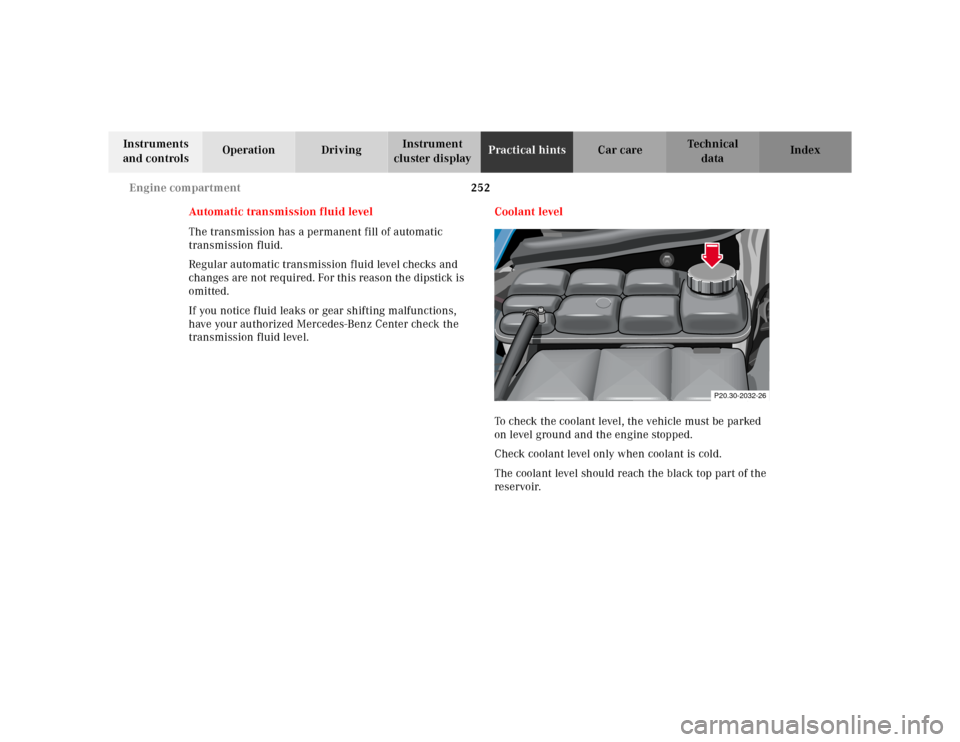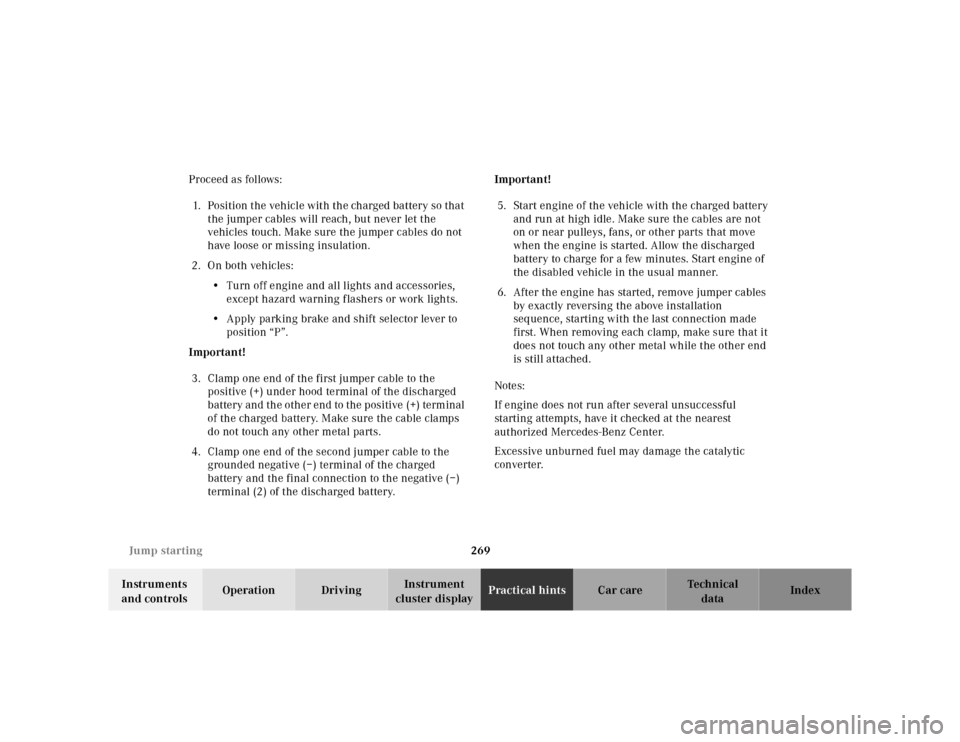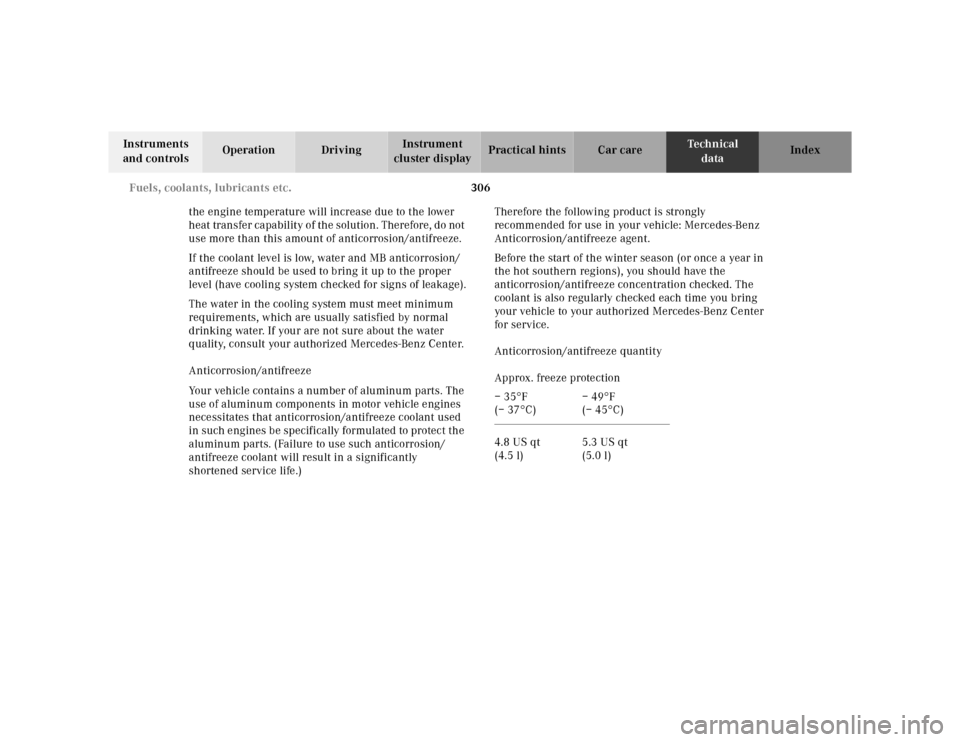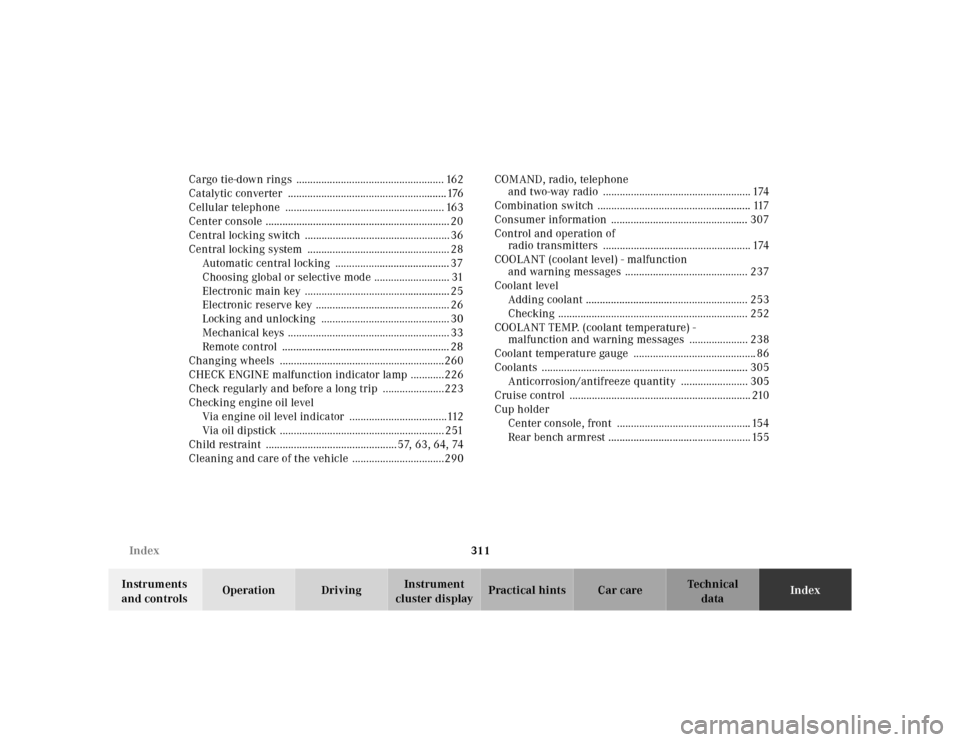2001 MERCEDES-BENZ CLK320 check engine
[x] Cancel search: check enginePage 255 of 325

252 Engine compartment
Te ch n ica l
data Instruments
and controlsOperation DrivingInstrument
cluster displayPractical hintsCar care Index
Automatic transmission fluid level
The transmission has a permanent fill of automatic
transmission fluid.
Regular automatic transmission fluid level checks and
changes are not required. For this reason the dipstick is
omitted.
If you notice fluid leaks or gear shifting malfunctions,
have your authorized Mercedes-Benz Center check the
transmission fluid level.Coolant level
To check the coolant level, the vehicle must be parked
on level ground and the engine stopped.
Check coolant level only when coolant is cold.
The coolant level should reach the black top part of the
reservoir.
P20.30-2032-26
Page 270 of 325

267 Battery
Te ch n ica l
data Instruments
and controlsOperation DrivingInstrument
cluster displayPractical hintsCar care Index Therefore, we strongly recommend that you have the
battery charge checked frequently, and corrected if
necessary, especially if you use the vehicle less than
approximately 200 miles (300 km) per month,
mostly for short distance trips, or if it is not used for
long periods of time.
Only charge a battery with a battery charger after the
battery has been disconnected from the vehicle’s
electrical circuit.
Always disconnect the battery negative lead first and
connect last.
When removing and connecting the battery, always
make sure that all electrical consumers are off and the
electronic key is in steering lock position 0. The battery
and its filler caps must always be securely installed
when the vehicle is in operation. During removal and
installation always protect the disconnected battery
positive (+) terminal with the cover attached to the
battery.
While the engine is running the battery terminal clamps
must not be loosened or detached, otherwise the
generator and other electronic components would be
damaged.Note:
After reconnecting the battery also set the clock (see
page 106), resynchronize the front seats (see page 49),
front seat head restraints (see page 49), the express
feature of the power windows (see page 147), the
sliding/pop-up roof (see page 149)and the electronic
stability program (ESP) (see page 218).
Battery recycling
Batteries contain material that can harm the
environment with improper disposal.
Large 12 Volt storage batteries contain lead.
Recycling of batteries is the preferred method of
disposal.
Many states require sellers of batteries to accept old
batteries for recycling.
Page 272 of 325

269 Jump starting
Te ch n ica l
data Instruments
and controlsOperation DrivingInstrument
cluster displayPractical hintsCar care Index Proceed as follows:
1. Position the vehicle with the charged battery so that
the jumper cables will reach, but never let the
vehicles touch. Make sure the jumper cables do not
have loose or missing insulation.
2. On both vehicles:
•Turn off engine and all lights and accessories,
except hazard warning flashers or work lights.
•Apply parking brake and shift selector lever to
position “P”.
Important!
3. Clamp one end of the first jumper cable to the
positive (+) under hood terminal of the discharged
battery and the other end to the positive (+) terminal
of the charged battery. Make sure the cable clamps
do not touch any other metal parts.
4. Clamp one end of the second jumper cable to the
grounded negative (–) terminal of the charged
battery and the final connection to the negative (–)
terminal (2) of the discharged battery.Important!
5. Start engine of the vehicle with the charged battery
and run at high idle. Make sure the cables are not
on or near pulleys, fans, or other parts that move
when the engine is started. Allow the discharged
battery to charge for a few minutes. Start engine of
the disabled vehicle in the usual manner.
6. After the engine has started, remove jumper cables
by exactly reversing the above installation
sequence, starting with the last connection made
first. When removing each clamp, make sure that it
does not touch any other metal while the other end
is still attached.
Notes:
If engine does not run after several unsuccessful
starting attempts, have it checked at the nearest
authorized Mercedes-Benz Center.
Excessive unburned fuel may damage the catalytic
converter.
Page 309 of 325

306 Fuels, coolants, lubricants etc.
Te ch n ica l
data Instruments
and controlsOperation DrivingInstrument
cluster displayPractical hints Car care Index
the engine temperature will increase due to the lower
heat transfer capability of the solution. Therefore, do not
use more than this amount of anticorrosion/antifreeze.
If the coolant level is low, water and MB anticorrosion/
antifreeze should be used to bring it up to the proper
level (have cooling system checked for signs of leakage).
The water in the cooling system must meet minimum
requirements, which are usually satisfied by normal
drinking water. If your are not sure about the water
quality, consult your authorized Mercedes-Benz Center.
Anticorrosion/antifreeze
Your vehicle contains a number of aluminum parts. The
use of aluminum components in motor vehicle engines
necessitates that anticorrosion/antifreeze coolant used
in such engines be specifically formulated to protect the
aluminum parts. (Failure to use such anticorrosion/
antifreeze coolant will result in a significantly
shortened service life.)Therefore the following product is strongly
recommended for use in your vehicle: Mercedes-Benz
Anticorrosion/antifreeze agent.
Before the start of the winter season (or once a year in
the hot southern regions), you should have the
anticorrosion/antifreeze concentration checked. The
coolant is also regularly checked each time you bring
your vehicle to your authorized Mercedes-Benz Center
for service.
Anticorrosion/antifreeze quantity
Approx. freeze protection
– 35°F
(– 37°C)– 49°F
(– 45°C)
4.8 US qt
(4.5 l)5.3 US qt
(5.0 l)
Page 314 of 325

311 Index
Te ch n ica l
data Instruments
and controlsOperation DrivingInstrument
cluster displayPractical hints Car careIndex Cargo tie-down rings ..................................................... 162
Catalytic converter .........................................................176
Cellular telephone ......................................................... 163
Center console .................................................................. 20
Central locking switch .................................................... 36
Central locking system ................................................... 28
Automatic central locking ......................................... 37
Choosing global or selective mode ........................... 31
Electronic main key .................................................... 25
Electronic reserve key ................................................ 26
Locking and unlocking .............................................. 30
Mechanical keys .......................................................... 33
Remote control ............................................................ 28
Changing wheels ...........................................................260
CHECK ENGINE malfunction indicator lamp ............226
Check regularly and before a long trip ......................223
Checking engine oil level
Via engine oil level indicator ...................................112
Via oil dipstick ........................................................... 251
Child restraint ...............................................57, 63, 64, 74
Cleaning and care of the vehicle .................................290COMAND, radio, telephone
and two-way radio ..................................................... 174
Combination switch ....................................................... 117
Consumer information ................................................. 307
Control and operation of
radio transmitters ..................................................... 174
COOLANT (coolant level) - malfunction
and warning messages ............................................ 237
Coolant level
Adding coolant .......................................................... 253
Checking .................................................................... 252
COOLANT TEMP. (coolant temperature) -
malfunction and warning messages ..................... 238
Coolant temperature gauge ............................................ 86
Coolants .......................................................................... 305
Anticorrosion/antifreeze quantity ........................ 305
Cruise control ................................................................. 210
Cup holder
Center console, front ................................................ 154
Rear bench armrest ................................................... 155
Page 315 of 325

312 Index
Te ch n ica l
data Instruments
and controlsOperation DrivingInstrument
cluster displayPractical hints Car careIndex
DDaytime running lamps .................................................115
Deep water
Driving instructions .................................................208
DISPLAY DEFECTIVE (engine control unit) -
malfunction and warning messages ......................232
DISPLAY DEFECTIVE (several systems) -
malfunction and warning messages ......................232
Display illumination ........................................................ 85
Doors .................................................................................. 34
Drinking and driving .................................................... 201
Drive sensibly - save fuel .............................................. 201
Driving instructions ...................................................... 201
Driving off .......................................................................203EELEC. STABIL. PROGR. - malfunction
and warning messages ............................................242
Electronic main key ......................................................... 25
Changing batteries ................................................... 281
Synchronizing remote control ................................283Electronic stability program (ESP)
Control switch ........................................................... 219
Malfunction and warning messages ..................... 242
Malfunction indicator lamp .................................... 229
Synchronizing ........................................................... 218
Warning lamp ........................................................... 229
Emergency call
See Tele Aid ...............................................................178
Emergency tensioning retractor (ETR) .........................65
Emergency trunk lid release button ............................. 41
Emergency unlocking in case of accident ...................37
Emission control ............................................................177
Emission control label .................................................. 298
Engine compartment .................................................... 249
ENGINE FAN - malfunction
and warning messages ............................................ 236
Engine malfunction
CHECK ENGINE
malfunction indicator lamp ............................... 226
Engine oil additives ...................................................... 303
Engine oil consumption ................................................ 113
Engine oil level
Checking .............................................................112, 251
Warning ......................................................................241